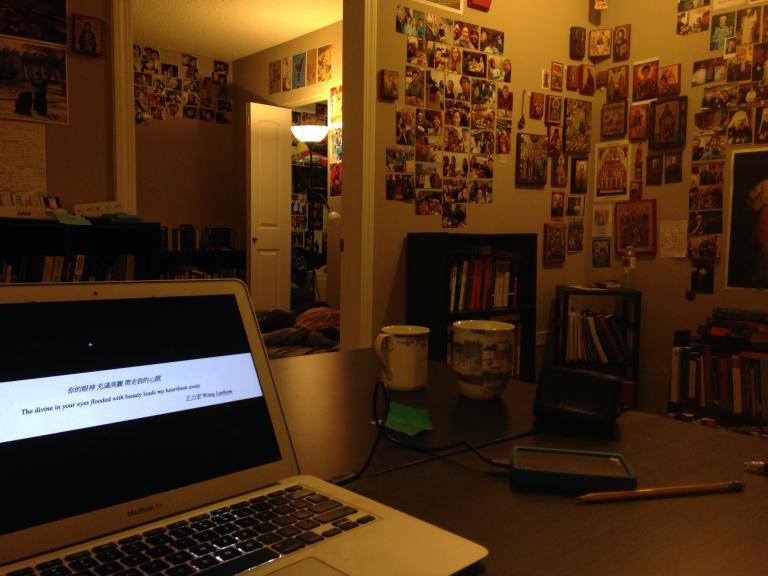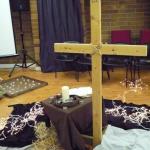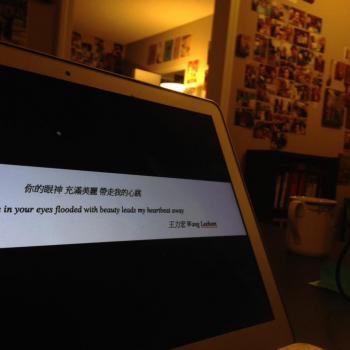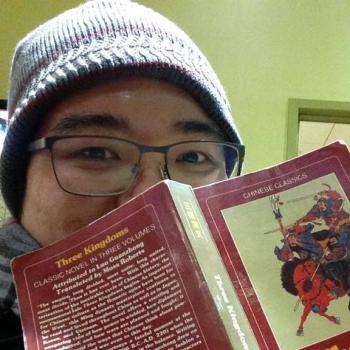
When I was about four, I once said to my elderly babysitter that my mom and dad were out with two lang lui, two pretty women. She guffawed — wahhhh! — and I knew that I had somehow made a mistake, except that I was pretty sure that these two women were beautiful. I was just at the point in my childhood development when it occurred to me that calling them jiejie, older sisters, wasn’t exactly accurate. My sister, who is younger than me, was born just a year before, and so having a real sister meant that these other people had to be put into another category. Lang lui, it was going to have to be.
They might as well have been my older sisters, though, because my dad was in the habit of calling them his lui, his daughters, in almost a more than adoptive sense. It was before he had received his training in pastoral psychotherapy, when he learned what transference and counter-transference were, and in that stage of innocence, it worked. I’ve gone back and forth on whether I think it was appropriate, and so has the rest of our family, and the consensus now is that it’s less creepy than what we thought when we got seriously burned by the churches where his ‘daughters’ and their husbands went (usually the husbands ended up on the boards, which was awkward). These days, I’m of the view that he might have been clearly in the clear, if a Chinese concept of family might be applied to them in which familial ties are much less biological and significantly more relational. That relation is purely social; my parents never crossed lines with them, so if anything, it was all very innocent. I also have very fond memories of my older sisters and want to keep them that way, with them as definitively my siblings in a real way, even though I don’t really have ties with them anymore.
The people who became my father’s daughters, and therefore my older sisters, were generally in their twenties when it happened, in times of courtship when they had doubts about the judgment of their biological parents about their boyfriends and wanted a pastoral opinion, which my dad provided as their pastor. From a young age, I became privy to a lot of romantic comedy, much more interesting than the movies, with actresses who were Chinese, often Cantonese, from Hong Kong, living in the San Francisco Bay Area. If the hyperreal images of representation were still normatively white in this early time in the nineties (though that too was being challenged, especially in my world by Ming-Na Wen, who was Chun Li before she was Jing-Mei in The Joy Luck Club, and all that before she was the voice of Mulan), my reality was chock full of the hilarious struggles of Cantonese people trying to work out love lives in a world of shifting norms. The most scandalous thing that ever reached my tender ears was that someone went ballroom dancing with a boyfriend. I did not learn about sex till much later.
The point is that the lang lui and their struggles was stuff that my older sisters dealt with. It was for grown-ups, women in their twenties, definitely not applicable to my own romance in preschool with a blonde with whom I spent one afternoon picking cherries and another friendship that went from then through elementary school with someone who danced the ribbon dance and knew all the cool folk stories, Chinese and western. What was the common factor, though, was that their ecclesial parental figures were my actual parents, which meant presumably that when my mom and dad helped them understand their lives in the context of the biblical story, they were also mapping the same textual grid onto my life. I also have great memories of learning the biblical romances, then — the stories of Abraham and Sarah, Isaac and Rebekah, Jacob and his love triangle with Rachel and Leah, Joseph and the saga with Potiphar’s wife, David and his many loves (including a girl named Michal and an older woman named Abigail and somebody he was not supposed to have seen naked, Bathsheba), and so on and so forth. As a family, we play-acted some of these stories during family devotions; one time, I even suggested that my mom could be Rahab the prostitute while my dad and I could be the two Israelite spies sneaking into Jericho, which was awkward because my parents had a very hard time explaining to a four-year-old what a prostitute was. Eventually, I acted out the scenes myself, both at home and at church, and mined the Book of Judges for creative fodder, especially after I saw the Hanna Barbera and Superbook episodes based on those very intriguing stories (especially Ehud the left-handed assassin).
All of these memories — both the lang lui and the biblical play-acting — have come back to me through this year’s Great Fast and well into the Great and Holy Week because we have spent time in Genesis, Isaiah, and Proverbs, and as Bridegroom Matins finishes up today with Great and Holy Wednesday, we have also been through our last minute marathon through all four Gospels and the entire Psalter. The Carpenters have that immortal song about every shalalala, every woah-oah-oah-oah and every shingalingaling, bringing Karen back to ‘yesterday once more’ (shoobeedoo aiwei), and that is literally what the readings have been doing to me. I reflect on why I always have those passages about the sluggard in Proverbs rolling through my mind when I am procrastinating, or the advice there about not getting caught in the schemes of the wicked, or in a bond altogether so that others are dependent on me, and I just sigh for the bygone innocence in which I first received this advice, either from reading Proverbs or hearing my mother read it to me. I think about the characters in Genesis, and how they have informed my sense of manhood and romance and competence and dream-work and even psychoanalysis and womanism, and I have also stumbled on some of my favourite critiques of religious communities in Isaiah. The language of the Psalter fills more of my everyday speech than I anticipated, especially when I attempt to wax poetic. If the Asian American writer Frank Chin calls us to go back into the language and stories of our childhood to explore the morality of martial heroism and historical imaginaries that inform it, I’m afraid that the texts and dramas, comedies and romances, that pepper my childhood are as much about the stories of Cantonese hero-deities as they are from the Bible. They are all right there with Disney, Captain Planet, and the Teenage Mutant Ninja Turtles.
Revisiting these texts and scenes might bring me back to those moments of innocence, but I suppose I am finally beginning to feel like an adult because I at last have a sense of why the lang lui were coming to my dad for romantic advice. Looking back, my older sisters were a motley crew of characters, each with strong personalities and their unique journeys with their boyfriends, husbands, and exes. But I feel like what made their struggles grown-up in contrast to my four-year-old life is that they had the capacity for regret. Like me, they too had grown up more or less in some churched way, and even if their Bible knowledge was not as comprehensive as mine came to be, there was a sense in which it formed their consciousness, in the sense that they sometimes did not heed the biblical counsel and wound up in a pickle — or worse, interpreted Scripture in a flawed way and got screwed by the actual situations they were in. I too now have regrets, a lot of them, as well as a sense of a shattered innocence that I’ll never get back. Reading Scripture is less about what I will do in the future as it is about what could have been, if only I were not so naïve, but then again, now that I am out of the garden, I appreciate these stories and the wisdom they contain so much more.
The kondak for Great and Holy Wednesday puts those who are at prayer on this day into the place of the sinful woman — the harlot, as the tropars call her with characteristic political incorrectness — who anointed Jesus’ feet with oil. The writers of the synaxarion reading seem very stressed out about who this woman is, attempting to harmonize the Gospel accounts with St John Chrysostom’s commentaries, to figure out whether she is the same woman as Mary of Bethany who anointed Jesus after he raised her brother Lazarus from the dead, or whether it is a sinful woman who is a copy-cat in the house of Simon the leper, or whether it is the same woman in the Gospel according to Luke who does the deed way before Jesus is even heading to Jerusalem in a house also belonging to Simon, but a Pharisee. It all seems so unnecessary — it’s almost as bad as Monty Python’s skit about the ‘holy hand grenade’ in their epically low-budget movie about the Holy Grail — until the canon is well under way and the tropars move among the three women that one has to remember that there are multiple passages depicted similar circumstances with slightly different scenes and probably different actresses. Whoever she is, of course, it is clear that she has her regrets. In regretting, she also prepares the Lord for his burial. For this reason, the Gospel according to Mark says, wherever the Gospel is preached her story will be told. Elizabeth Schüssler Fiorenza reminds us that therein lies the irony: the misogyny and the patriarchy that developed within the Christian churches has rendered her story all but forgotten, even on Great and Holy Week where more attention, at least in the western tradition, is paid to the Lord and his disciples approaching the Passion than on the days leading up to the Last Supper.
One hymnographer who did not forget this woman, though — likely because she herself was a woman — was Kassiani. Legend has it that Kassiani was brought before the emperor of Constantinople among a group that he was choosing a wife from, and she answered one of his questions with so much wit that it threatened his masculinity. He chose the woman next to her. She went to a monastery. Years later, when Kassiani was in the garden writing a hymn about the woman who anointed Jesus’ feet, the emperor arrived at her residence. Quickly putting down her pen, she hid herself. The emperor arrived, and seeing the poem leaving off with the words, I shall kiss Thy most pure feet and wipe them with the hairs of my head, added, those feet whose sound Eve heard at dusk in Paradise, and hid herself for fear. He then left, Kassiani came back to the piece, found the addition, and incorporated it. Now we sing the whole thing at the climax of Bridegroom Matins for Great and Holy Wednesday, at the end of the aposticha that concludes the service (here’s a sample a friend sent me):
The woman who had fallen into many sins, perceiving Thy divinity, O Lord, fulfilled the part of a myrrh-bearer; and with lamentations she brought sweet-smelling oil of myrrh to Thee before Thy burial. ‘Woe is me,’ she said, ‘for night surrounds me, dark and moonless, and stings my lustful passion with the love of sin. Accept the fountain of my tears, O Thou who drawest down from the clouds the waters of the sea. Incline to the groanings of my heart, O Thou who in Thine ineffable self-emptying hast bowed down the heavens. I shall kiss Thy most pure feet and wipe them with the hairs of my head, those feet whose sound Eve heard at dusk in Paradise, and hid herself for fear. Who can search out the multitude of my sins and the abyss of Thy judgments, O Saviour of my soul? Despise me not, Thine handmaiden, for Thou hast mercy without measure.
Wherever the Hymn of Kassiani is sung at Bridegroom Matins, the woman has not been forgotten. In fact, she is not only remembered. Kassiani is saying that she is us, just as I now find myself saddled with the same regrets as my older sisters, and just as we together are in the position of the woman preparing our Lord for burial.
I have been, I reflect, a child in the garden of Kassiani, observing the regrets of those older than me and resolving with biblical wisdom to avoid those mistakes. But I too now have plenty to regret, and this approach to Scripture, I feel, is what is so emphasized in the story of the woman anointing Jesus’ feet as repentance, the changing of our hearts that alters our consciousness. It is to turn back to the stories of my childhood, presumably the same ones that formed the woman who broke the alabaster jar, and to claim the wisdom that I have not always followed consistently again as my own. It is to re-visit even the scenes of heartache, like Kassiani and the emperor do, to draw from them the insight through which my mom and dad were presumably walking my older sisters. If I were in this scene, I was the kid playing hide-and-seek in the garden, but as I come to it this year, I realize that I am in the place of Kassiani and the king, the place of the sinful woman at Jesus’ feet, the place of my older sisters who now probably have much more to regret as their journeys have taken them through so much more than I can even imagine now. These were the tales that formed my life, the proverbs that continue to form my superego, and it is because of them that I can be wistful, even nostalgic, for an innocence that I do not have anymore. I have left the garden long ago. But I hear the feet of the Lord there still, and there I have turned back in prayer, singing the Hymn of Kassiani once again this year.












